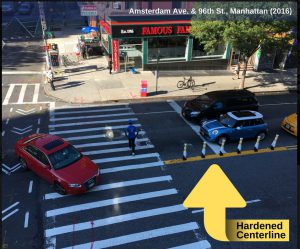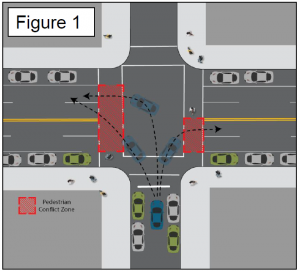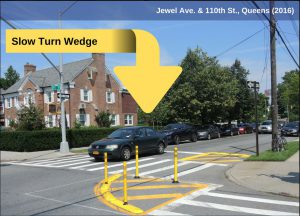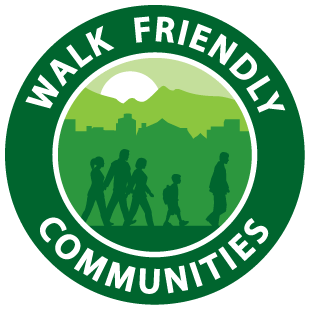 As part of its Vision Zero initiative, New York City has been implementing and evaluating a set of traffic calming measures focused on left turns at intersections, based on findings from the Left Turn Pedestrian and Bicyclist Study. Since 2016, the city has installed treatments in over 200 intersections. Treatments such as a ‘hardened centerline’ slow left turning traffic and change the characteristics of the turning movement to increase safety. At these intersections, the city has documented reduced turning speeds and fewer incidents of crossing double yellow lines when turning left. Officials expect to find that crashes have been reduced, once the data are available for longer-term evaluation.
As part of its Vision Zero initiative, New York City has been implementing and evaluating a set of traffic calming measures focused on left turns at intersections, based on findings from the Left Turn Pedestrian and Bicyclist Study. Since 2016, the city has installed treatments in over 200 intersections. Treatments such as a ‘hardened centerline’ slow left turning traffic and change the characteristics of the turning movement to increase safety. At these intersections, the city has documented reduced turning speeds and fewer incidents of crossing double yellow lines when turning left. Officials expect to find that crashes have been reduced, once the data are available for longer-term evaluation.
Traffic calming measures use physical and visual cues to slow traffic and minimize the number and severity of crashes, increasing safety and comfort for people walking and bicycling. Traffic calming is self-enforcing; the design of the roadway results in the desired effect and does not rely on behavioral interventions. If implemented correctly, traffic calming can be extremely effective in reducing crashes. Improved livability, which is not as easy to quantify, is an additional and equally important benefit derived from traffic calming.
 Street design is a central focus of New York City’s Vision Zero program. The city uses a system-wide data-driven process to identify locations for safety investments. Analysis of crash data revealed that vehicles turning left were involved in fatal or serious pedestrian or bicyclist crashes three times more often than vehicles turning right. Left turns can be dangerous for a few reasons. In most cases, left-turning radii are wide, which can lead to higher speeds and greater pedestrian exposure when crossing (see Figure 1). The driver’s visibility is also limited when turning left; it can be obscured by the A-pillar in the car and by parked cars. Additionally, left turns are more complex for drivers as they search for gaps in oncoming traffic.
Street design is a central focus of New York City’s Vision Zero program. The city uses a system-wide data-driven process to identify locations for safety investments. Analysis of crash data revealed that vehicles turning left were involved in fatal or serious pedestrian or bicyclist crashes three times more often than vehicles turning right. Left turns can be dangerous for a few reasons. In most cases, left-turning radii are wide, which can lead to higher speeds and greater pedestrian exposure when crossing (see Figure 1). The driver’s visibility is also limited when turning left; it can be obscured by the A-pillar in the car and by parked cars. Additionally, left turns are more complex for drivers as they search for gaps in oncoming traffic.
After examining crash reports and system-wide data, the city identified intersections where these crashes were most likely to occur. Crashes typically occurred at signalized intersections when vehicles where turning left from one-way streets onto two-way streets that were more than 60 feet wide.
 The city’s evaluations of a variety of previously implemented intersection traffic calming treatments demonstrated that changing the characteristics of left turns could reduce crashes involving pedestrians and bicyclists. The city began piloting left turn traffic calming treatments in 2016, completing these projects at approximately 100 intersections. In 2017, the city treated an additional 100 intersections. Benefits of the interventions include tightened turning radii, slower traffic speeds, and overall safer left turns. Both measures utilize rubber curb, plastic delineators, and pavement markings to accomplish the traffic calming effect. Where treatments have been installed, the DOT found a 20 percent reduction in average left turn speeds and an almost 80 percent reduction in crossing the double yellow line upon left turns.
The city’s evaluations of a variety of previously implemented intersection traffic calming treatments demonstrated that changing the characteristics of left turns could reduce crashes involving pedestrians and bicyclists. The city began piloting left turn traffic calming treatments in 2016, completing these projects at approximately 100 intersections. In 2017, the city treated an additional 100 intersections. Benefits of the interventions include tightened turning radii, slower traffic speeds, and overall safer left turns. Both measures utilize rubber curb, plastic delineators, and pavement markings to accomplish the traffic calming effect. Where treatments have been installed, the DOT found a 20 percent reduction in average left turn speeds and an almost 80 percent reduction in crossing the double yellow line upon left turns.
According to the city’s Vision Zero Year 4 Report, pedestrian fatalities are down 45 percent since the first year of the Vision Zero program, with fatality numbers steadily decreasing each year. Safer street design, including traffic calming interventions, continues to play a crucial role in improving pedestrian safety in New York City.
